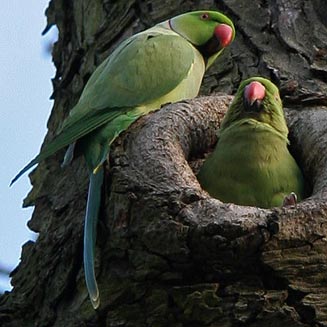|
Psittacula krameri (Rose-ringed parakeet)
Ringnekparkiet [Afrikaans]; Halsbandparkiet [Dutch];
Perruche à collier [French]; Halsbandsittich [German]; Periquito-de-colar
[Portuguese]
Life
> Eukaryotes >
Opisthokonta
> Metazoa (animals) >
Bilateria >
Deuterostomia > Chordata >
Craniata > Vertebrata (vertebrates) > Gnathostomata (jawed
vertebrates) > Teleostomi (teleost fish) > Osteichthyes (bony fish) > Class:
Sarcopterygii (lobe-finned
fish) > Stegocephalia (terrestrial
vertebrates) > Tetrapoda
(four-legged vertebrates) > Reptiliomorpha > Amniota >
Reptilia (reptiles) >
Romeriida > Diapsida > Archosauromorpha > Archosauria >
Dinosauria
(dinosaurs) > Saurischia > Theropoda (bipedal predatory dinosaurs) >
Coelurosauria > Maniraptora > Aves
(birds) >
Order: Psittaciformes > Family: Psittacidae
 |
|
|
Rose-ringed parakeets, Amsterdam, Holland. [photo
Hamish Robertson, Iziko ©] |
|
The Rose-ringed parakeet is not indigenous to southern
Africa, but is rather and introduced species, with feral populations centred
around Durban and Johannesburg. It occurs in a wide variety of habitats, ranging
from savanna to riparian woodland, however it is most common in parks, gardens,
farmland and other man-made habitats. It is highly sociable and gregarious,
feeding mainly on fruit and seeds. It nests in tree cavities, either natural or
made by barbets, but also uses rock crevices, buildings and nest boxes. Here it
usually lays 3-4 eggs which are incubated mainly by the female, for about 28
days. The chicks stay in the nest for about 6-7 weeks, becoming fully
independent a few months later.
Distribution and habitat
Not indigenous to southern
Africa, as instead it is introduced species, with feral populations centred
around Durban, KwaZulu-Natal and Johannesburg, Gauteng. It is indigenous to the
Sahel area, from Senegal to Ethiopia, with other populations in southern Asia.
It occurs in a wide variety of habitats, ranging from savanna to riparian
woodland, however it is most common in parks, gardens, farmland and other
man-made habitats.
Food
The following food items have been recorded in its diet:
- Plants
- fruit
- Ficus (figs)
- alien species
- Mangifera indica (Mango)
- Syzigium cumini (Jambolan Plum)
- Livistona chinensis (Chinese fan-palm)
- Litchi chinensis (Litchi)
- Pleiogynium cerasiferum (Dutch Apples)
- seeds
- Eucalyptus
- Araucaria heterophylla (Norfolk pine)
- Erythrina (coral-trees)
- Insect larvae (rarely)
Breeding
- Its breeding habits are little known in South
Africa.
- It nests in tree cavities, either natural or made by barbets, but it may also
use rock crevices, buildings and nest boxes.
- It usually lays 3-4 eggs, which are incubated mainly by the female for
about 28 days.
- The chicks stay in the nest for about 6-7 weeks, becoming fully
independent a few months later.
Threats
As it is an alien species it requires no conservation,
however internationally it is common and not threatened.
References
-
Hockey PAR, Dean WRJ and Ryan PG (eds) 2005. Roberts -
Birds of southern Africa, VIIth ed. The Trustees of the John Voelcker
Bird Book Fund, Cape Town.
|
